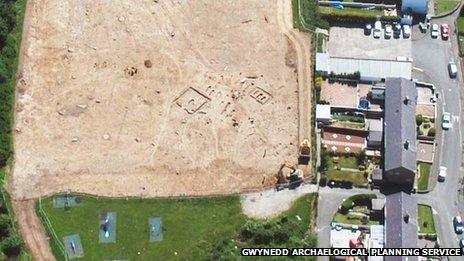Caernarfon dig finds Roman construction site and medieval cemetery
- Published

An aerial view shows the 'grid' of the graves believed to be Christian
A dig on a piece of land in Gwynedd destined for a new school has resulted in the first discovery in Wales of a Roman construction camp.
The Caernarfon dig was carried out before the new Ysgol yr Hendre school was built, but the results of detailed analysis have only been released.
An early medieval cemetery was also unearthed from a later, lesser known period of Caernarfon's history.
The Romans had a fort called Segontium near Caernarfon from AD77 until AD393.
The two new findings contribute to a "better understanding" of life either side of the Roman occupation, according to the Gwynedd Archaeological Trust (GAT), external which carried out the work.
Jane Kenney of the Gwynedd Archaeological Trust talks to Oliver Hides
The first revealed a cemetery dating to a time shortly after the withdrawal of Roman troops from Segontium, whilst the second identified a temporary camp set up by Roman soldiers during the initial construction phases of the main fort.
Comparison with other sites suggested the cemetery was in use during the period AD500 to AD700, at least one hundred years after the fort was abandoned.
'Fills the gaps'
Previously there was very little evidence of people living near the site after the Romans left Segontium.
"This is a very important site, and it is very exciting when anything as early as this medieval cemetery is discovered," said Jane Kenny, a senior archaeologist with the Gwynedd Archaeological Trust.
"It ties in the Roman fort and the medieval town and as it happens in between the two [time-wise] it hints at a settlement and fills in some of the gaps.
"It fits neatly in the town's history."

The ovens found on the site were a surprise to archaeologists.
As the dig progressed excavations also revealed a series of double pits in a figure-of-eight shape scattered amongst the graves.
Experts interpreted them as pit ovens - one side was for the cooking, whilst the embers were scraped over to the other side.
Radiocarbon dating and statistical analysis was then used to date the ovens to the time the Segontium fort was under construction.
"The Roman construction site was a surprise - we didn't know what the areas were, so close to the construction of the [Segontium] fort in Llanbeblig," said Ms Kenny.
"A nice ditch [around the site] would have proved it nicely, but otherwise the evidence shows it must have been where the soldiers lived whilst constructing the fort."
Despite the areas around the Ysgol yr Hendre site now being mostly residential Ms Kenny believes some remains might still lay hidden under the soil.
"We didn't find one corner of the cemetery and things might survive in gardens, or in gaps that haven't been built on yet," she added.
- Published12 March 2012
- Published1 June 2011
- Published22 July 2010